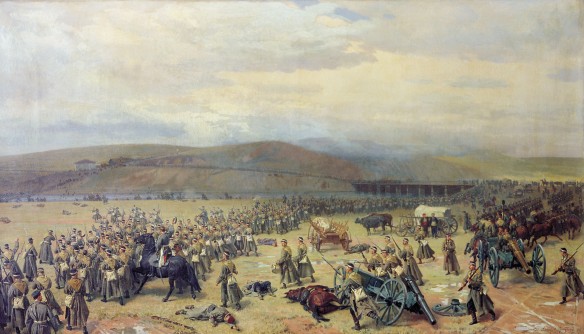Battle of Plevna, in 1877, was a major battle of the Russo-Turkish War (1877–78), fought by the joint army of Russia and Romania against the Ottoman Empire. The Ottoman defense held up the main Russian advance southwards into Bulgaria, encouraging other great powers of the time to actively support the Ottoman cause. Eventually, superior Russian and Romanian numbers forced the garrison to capitulate.
Alexander II’s era of the Great Reforms marked an important watershed for both services. In a series of reforms between 1861 and 1874, War Minister Dmitry Alexeyevich Milyutin created the foundations for a genuine cadre- and reserve-based ground force. He facilitated introduction of a universal service obligation, and he rearmed, reequipped, and redeployed the army to contend with the gradually emerging German and Austro-Hungarian threat along the Empire’s western frontier. In 1863–1864 the army once again suppressed a Polish rebellion, while in the 1860s and 1870s small mobile forces figured in extensive military conquests in Central Asia. War also flared with Turkey in 1877–1878, during which the army, despite a ragged beginning, inconsistent field leadership, and inadequacies in logistics and medical support, acquitted itself well, especially in a decisive campaign in the European theater south of the Balkan ridge. Similar circumstances governed in the Transcausus theater, where the army overcame initial setbacks to seize Kars and carry the campaign into Asia Minor.
Following the war of 1877–1878, planning and deployment priorities wedded the army more closely to the western military frontier and especially to peacetime deployments in Russian Poland. With considerable difficulty, Alexander III presided over a limited force modernization that witnessed the adoption of smokeless powder weaponry and changes in size and force structure that kept the army on nearly equal terms with its two more significant potential adversaries, Imperial Germany and Austria-Hungary. At the same time, the end of the century brought extensive new military commitments to the Far East, both to protect expanding imperial interests and to participate in suppression of the Boxer Rebellion (1900).
First Russian torpedo vessel Vzryv (1877). She was armed with a bow underwater torpedo tube.
The same challenges of force modernization and diverse responsibilities bedeviled the navy, perhaps more so than the army. During the 1860s and 1870s, the navy made the difficult transition from sail to steam, but thereafter had to deal with increasingly diverse geostrategic requirements that mandated retention of naval forces in at least four theaters (Baltic, Northern, Black Sea, and Pacific), none of which were mutually supporting. Simultaneously, the Russian Admiralty grappled with issues of role and identity, pondering whether the navy’s primary mission in war lay either with coastal defense and commerce raiding or with attainment of true “blue water” supremacy in the tradition of Alfred Thayer Mahan and his Russian navalist disciples. Rationale notwithstanding, by 1898 Russia possessed Europe’s third largest navy (nineteen capital ships and more than fifty cruisers), thanks primarily to the ship-building programs of Alexander III.
